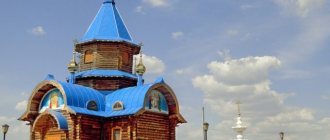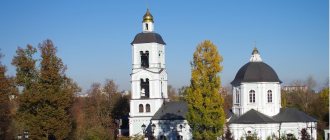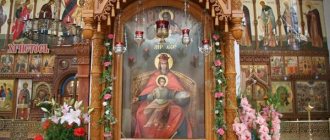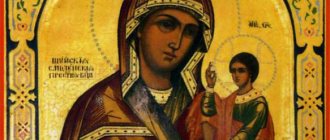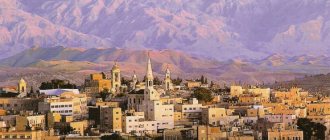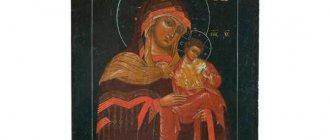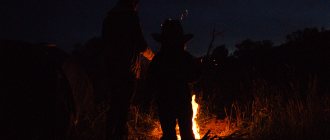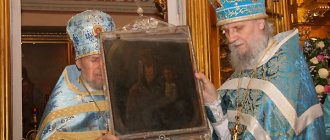Mir
Russia Leningrad region Tervenichi village Source of the Tervenic Icon of the Mother of God Map loading in progress...
{"format":"leaflet","minzoom":false,"maxzoom":false,"limit":50,"offset":0,"link":"all","sort":[""], "order":[],"headers":"show","mainlabel":"","intro":"","outro":"","searchlabel":"\u2026 \u0441\u043b\u0435\ u0434\u0443\u044e\u0449\u0438\u0435 \u0440\u0435\u0437\u0443\u043b\u044c\u0442\u0430\u0442\u044b","default":"","import-annotation":false,"width ":"auto","height":"350px","centre":{"text":"","title":"""link":"""lat":60.31891999999999853798726690001785755157470703125,"lon": 34.1045299999999969031705404631793498992919921875,"icon":""},"title":"","label":"","icon":"","lines":[],"polygons":[],"circles":[ ],"rectangles":[],"copycoords":false,"static":false,"zoom":8,"defzoom":14,"layers":["OpenStreetMap"],"image layers":[] ,"overlays":[],"resizable":false,"fullscreen":true,"scrollwheelzoom":true,"cluster":false,"clustermaxzoom":9,"clusterzoomonclick":true,"clustermaxradius":80, "clusterspiderfy":true,"geojson":"","clicktarget":"","showtitle":true,"hidenamespace":false,"template":"","userparam":"","activeicon": "","pagelabel":false,"ajaxcoordproperty":"","ajaxquery":"","locations":[{"text":"\u003Cb\u003E\u003Ca href=\"/palomnik/%D0% 98%D1%81%D1%82%D0%BE%D1%87%D0%BD%D0%B8%D0%BA_%D0%A2%D0%B5%D1%80%D0%B2%D0%B5% D0%BD%D0%B8%D1%87%D0%B5%D1%81%D0%BA%D0%BE%D0%B9_%D0%B8%D0%BA%D0%BE%D0%BD%D1% 8B_%D0%91%D0%BE%D0%B6%D0%B8%D0%B5%D0%B9_%D0%9C%D0%B0%D1%82%D0%B5%D1%80%D0%B8\ » title=\»\u0418\u0441\u0442\u043e\u0447\u043d\u0438\u043a \u0422\u0435\u0440\u0432\u0435\u043d\u0438\u0447\u0435\u0441\u043a\u0 43e\u0439\u0438\ u043a\u043e\u043d\u044b \u0411\u043e\u0436\u0438\u0435\u0439 \u041c\u0430\u0442\u0435\u0440\u0438\u003E\u0418\u0441\u0442\ u043e\u0447\u043d\u0438\ u043a \u0422\u0435\u0440\u0432\u0435\u043d\u0438\u0447\u0435\u0441\u043a\u043e\u0439 \u0438\u043a\u043e\u043d\u044b \u0411\u 043e\u0436\u0438\u0435\u0439\ u041c\u0430\u0442\u0435\u0440\u0438\u003C/a\u003E\u003C/b\u003E","title":"\u0418\u0441\u0442\u043e\u0447\u043d\u0438\u043a\u0422 \u0435 \u0440\u0432\u0435\u043d\u0438\u0447\u0435\u0441\u043a\u043e\u0439 \u0438\u043a\u043e\u043d\u044b \u0411\u043e\u0436\u0438\ u0435\u0439\u041c\u0430\u0442 \u0435\u0440\u0438","link":"","lat":60.31891999999999853798726690001785755157470703125,"lon":34.104529999999996903170540463179349899 2919921875,"icon":""}],,"imageLayers":[]}
60.320905; 34.099913
Russia, Leningrad region, Lodeynopolsky district, Alyokhovshchinskoye rural settlement, Tervenichi village, Shkolnaya street
Tervenichi village, Leningrad region
Russia
Telephone:
+7-921-422-97-50; +7-931-245-42-34
Source at the Intercession Tervenichesky convent.
History[[edit]h2>
Interior decoration
The discovery of a source on the territory of the monastery is associated with the appearance of the Tervenic Icon of the Mother of God.
At the beginning of the winter of 1992, in a subtle dream, the Mother of God appeared to the founder and spiritual father of the monastery, standing on Tervenicheskaya land, at Her feet lay an icon similar to Kasperov’s, from under which water flowed. The Mother of God pointed with her hand to the lying icon. This event is depicted on the icon “Appearance of the Mother of God in Tervenichy”. In the spring of the same year, a fontanel was discovered at the place indicated by the Mother of God. The water began to be blessed regularly. It has been noted that the water from the spring has healing powers. For the convenience of collecting water, a well was dug in that place. A small wooden chapel was built above it in honor of the appearance of the Mother of God.
In 1997, instead of a wooden one, a stone chapel was built over the source. Every Sunday a prayer service is held in the Nadkladeznaya Chapel.
Trip to Tervenici
About 10 years ago, on a stormy St. Petersburg day, I happened to find myself in a small strange building on the corner of Petersburg Highway and Leninsky Prospekt. At the entrance to the smoke-stained building, which looked the least like a church, there was a sign explaining that this was the church of the holy martyrs Faith, Hope, Love and their mother Sophia, administered by the Moscow Patriarchate. In the twilight of the temple, several small icons were hung on the walls, apparently brought from home by parishioners, and candles were glowing, inserted, due to the lack of candlesticks, into the sand poured into the boxes. But despite this church being deprived of the beauty that Russian churches have always been famous for, it was surprisingly good. The feeling of purity and light, mysteriously spilled in a dark room, made us remember the spirit of the catacombs, from which the first Christians offered their prayers to God. The light invisible to my bodily eyes, which I felt in the Church of Faith, Hope, Love and their mother Sophia, illuminated the gray November day and filled it with spiritual meaning.
A few years later, during an unusually hot summer for St. Petersburg, I had to visit these places again. Then, in the sweltering July heat, at about 12 noon, in the area of the faceless Brezhnev residential cubes of Leninsky Prospekt, the languid presence of the “midday demon” was especially noticeable. But sparkling with whiteness, reminiscent of the color of Christ’s vestments, the small church near the bright green trees of the wasteland and the remains of a picturesque lake seemed like an oasis of Hope. In this temple the life-giving power of the inexhaustible source of Faith and Love seemed especially palpable. Unlike the temple buildings in its architecture, the church without a dome stood surrounded by the newest residential buildings. The temple was whitewashed inside and out, brightly lit by the light of many candles in bronze candelabra. Large icons appeared in it, from the writing technique of which and the freshness of the colors one could understand that they had been painted recently; it was felt that the same hands that created the icons painted the church itself and decorated the altar.
In the narthex above the entrance hung a rather unusual icon of the Mother of God, depicting the Mother and Son leaning towards each other. I was surprised by the rapid, lower than on other icons of this iconographic version, inclination of the head of the Mother of God, illuminated by a halo, towards the Infant God in her arms. Then they told me that the unusual icon is called Kasperovskaya, has its own history and is considered the guardian of the city of Odessa, from which the young priest was from, who had recently graduated from the St. Petersburg Theological Seminary.
Entering the temple, I plunged into the special atmosphere of the church, where all the parishioners sang prayers together with the priest (a phenomenon, unfortunately, not found in all churches). Women, many with tears in their eyes, lifted their children up so that they could see the liturgy - a divine act during which the soul feels especially good.
After that July day, I often visited this increasingly beautiful church. And every time, rising from the metro on Leninsky Prospekt, as if from the underground depths of St. Petersburg, and walking to the cacophonous sounds of modern rhythms heard from the stalls, past monstrous beggars and screaming street vendors selling underwear or the fruits of their garden plots, past the abysmal shaven-headed boys in uniform guarding the zones spheres of racketeering dominion, I thought about the meeting with God that lay ahead of me in a small church on the corner of Leninsky Prospekt and Peterhof Highway.
Old Petersburg, as you know, was built at the bottom of a huge geological depression, at the exit of which, along its edges, are Tsarskoe Selo, Pulkovo, Pargolovskaya Poklonnaya Gora, and other St. Petersburg suburbs. Somewhat lower, on the former dacha territory, where now the arrow of Leninsky Prospect pierced the Peterhof Highway, 10 years ago, in the premises of an abandoned country dacha of pre-revolutionary times, Hieromonk Lukian (Kutsenko) decided to create a church. In relation to old St. Petersburg, this church is located on a hill. And located at the exit from the Neva valley, where it seems that the path from St. Petersburg hell to heaven has almost ended, the wonderful church, along with the churches of Tsarskoe Selo, undoubtedly represents the paradise of St. Petersburg. Climbing the steps of the Leninsky Prospekt metro station, I often felt like I was ascending from the bottom of the Neva Gorge towards the light. In this once flourishing area on the left side of the highway, remnants of its former beauty are still preserved in the form of fragments of picturesque meadows and lakes. Modern residential buildings now stand on their banks. The Church of Faith, Hope, Love and their mother Sophia made the presence of Sophia the Wisdom visible in one of the residential areas of St. Petersburg and brought meaning to the existence of its residents.
During my visits to the church, I heard more than once about the sisterhood created by the rector and parishioners of this church in the Lodeynopolsky district of our region, and about the miracles that happen there. I found out that in the Church of Faith, Nadezhda, Lyubov and Sophia there hung only a copy of the Kasperov icon, or rather one of its copies, located in Tervenichy, a remote place in the North-West of Russia in which the sisterhood settled. Found through the efforts of the abbot and parishioners, the destroyed Church of the Intercession in Tervenichi received its first sisters in 1991. And although I have repeatedly heard oral stories about subsequent events in Tervenichi, in order to avoid any distortions, I am forced to present the history of the sisterhood according to the book “Intercession-Tervenichi Monastery” (1996 ), published by the monastery, and I will rely on quotes from it.
Initially, the place and position of the sisterhood bore little resemblance to him. Inspired by faith, a small group of women courageously reclaimed the temple grounds, cleared the dilapidated temple, and planned a monastery. The lack of housing, the severity of winter, and the empty, uninhabited place did not disappoint the workers. In 1996, the church was largely restored, utility rooms, two residential buildings were built, and a garden was planted.
The sisterhood needed, following the example of many historical monasteries, to have a source and shrines - the main spiritual assets of the monastery. Human efforts, although the most noble and pious, had no success. Five attempts to find water on the territory of the monastery brought only disappointment, although the wells were dug to great depths.
The problem with the especially revered icon of the Mother of God for the monastery also did not have a solution for a long time. It was difficult for the community to obtain an ancient image celebrated on the day of the Intercession of the Blessed Virgin Mary on October 14 (Lublinskaya, Pskovo-Pokrovskaya, Kasperovskaya, Brailovskaya, Gerbovetskaya, Barskaya). The rector and confessor of the sisterhood was confident in the possibility of obtaining for the monastery an ancient copy of the miraculous image of Kasperovskaya, with whom he was born and spent his childhood and youth.
But God and the Mother of God wanted something else, so the efforts of the confessor by the Providence of God were unsuccessful. It was not possible to purchase the ancient image of Kasperovskaya; it was decided to find another icon, celebrated on October 14. But on the same day, one of the monks who took part in the search, in a subtle dream, was transported in spirit from a distant southern city to the town of Tervenichi, where the Mother of God herself commandingly indicated the location of the source and an icon that clearly resembled the Kasperovskaya type, although without an inscription. After this vision, efforts were again made to search for the icon, but to no avail, and only after many efforts with strong faith in the will of the Mother of God, the icon, exactly the same as the one indicated by the Queen of Heaven, was found in the storerooms of the workshop of one of the Odessa artists. There was no limit to the joy and excitement. Following the happy news of the vision and discovery of the icon, indicated by the Mother of God herself, the sisterhood and parishioners of the Church of the Holy Great Martyrs prepared for a solemn meeting.
Meanwhile, in distant Tervenichy, one of the first nuns, who knew nothing about this, who had not previously experienced anything supernatural in her life, either in reality or in a dream, the following was revealed: during night prayer, the nun heard a powerful, but soft and beautiful voice, clearly who said: “The sooner you have my icon, the sooner my help will come to you.”
Upon arrival at the parish of St. The icon of the martyrs was immediately taken to the monastery, not without fear and anxiety. At the place indicated by the Mother of God in a dream, the abbot and the monastics discovered a spring. The icon was placed in the place of the spring, as indicated in the dream, then the first prayer service was served, after which miracles began to occur abundantly from the icon and the water of the spring.
After a prayer service and procession with the icon around a large plot of land, the powers that be, unknowingly, offered and transferred to the monastery exactly as much land as was “measured” by the icon.
Many healings began to take place at the icon and the source, which were recorded in the monastery diary. There are many living witnesses of these healings. In gratitude for the manifestation of God's mercy from the icon, believers donated a lot of gold jewelry, some of which went to the needs of the temple, and some remained with the holy icon.
Several times pilgrims noticed tears in the eyes of the Mother of God, but with the blessing of the confessor, what was seen was not disclosed.
The most obvious and powerful manifestation of the power of God was the flow of myrrh from the newly painted icon, conveying the appearance of the Mother of God in Tervenichy. The history of this myrrh-streaming is as follows. Due to the inept construction of the wooden frame at the source, the water began to emit an unpleasant odor, although it retained its healing properties. The log house was so sunk into the clayey soil that it was impossible to remove it using simple means. Even bringing in technology was unsuccessful. Many omissions and half-statements about the actual appearance of the Mother of God gave rise to doubts and rumors among the nuns of the monastery and visiting pilgrims. It was decided to dig a new well below the previous one, retreating only a few meters.
They dug not one, but three wells even below the lake, but there was not a drop of water. Human calculations and lack of faith were put to shame by Divine Providence to the greater glory of God and the Mother of God. At this time, it was discovered that in the local row of the iconostasis of the cell church, the image of the Appearance of the Mother of God in Tervenichi, written from the words of someone who saw the appearance of the Mother of God in a dream, was streaming myrrh. Drops of the world covered the hem of the tunic, the feet of the Virgin Mary standing over the source, and the piece of earth where the icon lay.
The event of myrrh-streaming became a clear indication from the Mother of God of the holiness and immutability of the place of the source and the undesirability of the undertaking. The monks themselves, with repentant feelings, with their own hands, with great difficulty, removed the old frame and built a new stone one in the same place. The dug wells were filled in.
The myrrh-streaming of the icon of the Mother of God in Tervenichy continued for a whole year; anyone who visited the monastery could be an eyewitness to this phenomenon. The myrrh streaming was filmed. Considering what was happening, as a sign of gratitude for the mercies and grace-filled manifestations from the icon indicated by the Mother of God herself, it was decided to call this image of the Mother of God Tervenic. Previously, the icon was inscribed as Kaspero-Tervenicheskaya, which many were perplexed about, since the originally acquired image did not have an inscription, although it was written according to the Kasperovskaya type. After such a decision, the tears and myrrh streaming on the icon disappeared, which made it possible to inscribe the icon depicted at the feet of the Mother of God as Tervenic. This was seen as the approval and blessing of the Queen of Heaven herself.
At the time when the brochure, the text of which I used, was published, a chapel had not yet been erected over the monastery spring, there were no cases of new miraculous healings in the monastery and myrrh-streaming of icons, including a list of the Tervenic icon in the monastery monastery, 20 km distant from Tervenichy . The temple in the monastery, where the icon-painting and art workshops of the monastery were located, was not consecrated in the name of the “Inexhaustible Chalice” icon, which helps to get rid of the disease of drunkenness to which the local population is susceptible.
Father Lukian (Kutsenko) had not yet been transferred from the Church of Faith, Hope, Love and their mother Sophia to revive the Alexander-Svirsky Monastery, located, like Tervenichy, in the vicinity of Lodeynoye Pole. The decree of the Synod of April 14, 1997 on the opening of the Intercession-Tervenichesky Monastery had not yet been issued, and the blue dome-turret had not yet appeared over the church of the holy martyrs Faith, Nadezhda, Lyubov and their mother Sophia.
The monastery, created by parishioners of the St. Petersburg Church of Faith, Hope, Love and Sophia, is a unique phenomenon in the life of the modern Russian Orthodox Church. Everyone knows how much work needs to be done to revive the old monastery. But create a new one! There is no longer enough money, no strength, and most importantly, the ascetic spirit, which was exterminated in the long-suffering Russian Church all the years of Soviet power, and sometimes even earlier.
It may seem obvious to anyone, even just guessing about the processes of historical word formation in the Russian language, that the name Tervenici is associated with the “crown of thorns”. However, it is believed that the name of the village comes from the Vepsian “hello, welcome”. But God had to pay special attention to the place in the name of which the “crown of thorns” clearly sounds, despite the fact that the historical origin of the word might have nothing to do with the divine sound. God is the Word. Christ is the incarnate Logos. Therefore, God's attention should be attracted to human words when Christ is revealed in their sound. Having the shape of a circle - one of the symbols of Wisdom - the crown of thorns signifies the Christian idea of transformation through death. People saw the heavenly divine light in the “bright darkness” on Mount Horeb and Tabor. But on another mountain - Golgotha - death was accepted with a crown of thorns. This crown recalls the thorn bush from which God spoke to Moses on Mount Horeb. It is no coincidence that the thorn bush is depicted on the “Burning Bush” icons as a burning circle entwined with green thorns, inside which is an image of the Mother of God of the Sign, i.e. Sofia.
The Tervenichs have a long, difficult and terrible history. The name of the Tervenichesky churchyard was first mentioned in the Charter of Prince Svyatoslav Olegovich in 1137, which lists all the churchyards of the Ladoga and Onega region, including Tervenichy. But the settlement itself arose, of course, earlier. Russians and Vepsians, an ancient Finno-Ugric people, settled here from the very beginning. Already seven centuries ago in Tervenichy there was the estate of the Anthony-Dymsky Monastery, located 13 versts from Tikhvin. The monastery lands were transferred to the treasury by Catherine II, and then went to the landowner. The Tervenichs, as part of the Novgorod land, were subjected to oprichnina raids and suffered severely from their atrocities. During the time of Peter I, the local population was forcibly assigned to the iron foundries. As a result of many victims, there were times when only a few households remained in Tervenichy. This place also suffered during the years of forced collectivization, Stalinist repressions, and during wartime.
Over the course of seven centuries, many churches and chapels arose here, which perished under various circumstances. The last stone Church of the Intercession of the Mother of God was built at the beginning of the 20th century, closed in 1937 and finally destroyed after the war, not without the participation of the local population. The church that has now been restored from the ruins in its place is somewhat different from the original.
Human suffering in Tervenichy was not always suffering in the name of Christ. But Christ, who dwells here in the crown of thorns and atones for the sins of people, made their torment a continuation of his atoning Sacrifice, embodied in the name of the place. He put his martyr's crown on the Tervenich sufferers, but as punishment for their unbelief and unworthiness, he allowed the churches that stood here, and therefore Himself, to be destroyed, for the churches are Christ, His Body. And the destroyed churches can be considered the redemptive crown of thorns of Christ. Perhaps this is one of the reasons that miracles are now happening on the mountain near the lake and God’s presence is so palpable. It seems that the ancient churchyard was waiting for the current church and the torment of the people in Tervenichy was for the sake of its appearance here.
When you climb up the mountain to the temple, clear silhouettes of trees appear in front of you, as if painted in the evening sky. Then the bell tower spire and the facade of the church appear, then the blue dome and unusual cell buildings, and at the same time a view opens onto a beautiful, discreet northern beauty of a hilly valley with a lake and forest around it. And then you begin to understand that there cannot be a closed space isolated from the world on the mountain. For the mountain, towering above the terrain, and with it above us, although directed into the sky, is still part of the earth’s space. And trying to push off from it, to fly too high, we only become even more attracted to the ground. Mount Tabor is part of it. The monastery mountain in Tervenichy awakens the image of Tabor in the soul. It’s as if Christ Himself descends from this mountain into the Neva valley, as He descended into Jereel from Mount Tabor. At the foot of the Mount of Transfiguration, Jesus casts out the “dumb and deaf spirit” for good from the demon-possessed youth and the raging St. Petersburg. But we must help Him, following the father of the crazy youth, saying to ourselves: “I believe, Lord! Help my unbelief” (Mark 9:15). Then our life at the bottom of the St. Petersburg depression will be illuminated by the Tabor light, with which the Face of Christ shone after descending from the Mount of Transfiguration, so that “when they saw Him, all the people were amazed” (Mark 9:15). A place called Tervenici has been waiting for this church and this monastery for seven centuries! Many years to you, oh. Lucian, sisters and brothers of the Intercession-Tervenichesky and Alexander-Svirsky monasteries!
The recent, in the summer of 1998, the second discovery of the relics of St. Alexander of Svirsky inspires faith in the future of the North-West of Russia and the St. Petersburg region in particular, strengthens our hope. This event, which is related not only to the ancient Alexander-Svirsky Monastery and the entire North-West of the country, but again specifically to the Church of Faith, Hope, Love and Sophia on the Peterhof Highway, still requires its own understanding.
Nachalo magazine No. 7, 1999
If you find an error, please select a piece of text and press Ctrl+Enter.
Similar
Pilgrim[[edit]h2>
The Intercession-Tervenichesky Monastery is open to people who want to visit it.
You can come to the monastery for different purposes and, accordingly, in different capacities: tourist, pilgrim or worker.
Before you take a trip, you need to think about its purpose, because... it will require inner readiness from you, because even the path to the monastery is not close.
I would like to talk about the old tradition of visiting monasteries, which many people forget about today. It was not customary to come to the monastery empty-handed. The opportunity to support the monastery in some way was understood as a great benefit for oneself. The gift could be small, but from the heart. It could be food or something necessary for worship, or simply for the daily life of the inhabitants. People knew that according to the laws of spiritual life, by giving, they gain much more for themselves.
Attention! Those wishing to stay in the monastery for more than one day must have a passport and money for the return journey. (The road from the village of Tervenichi to St. Petersburg costs about 450 rubles; from the village of Tervenichi to the city of Lodeynoye Pole - 110 rubles.)
Clergy and monastics must have a church ID in addition to their passport.
Telephone:
+7-921-422-97-50; +7-931-245-42-34
Monastery website
How to get there[[edit]h2>
Directions:
To the monastery:
by bus or train to the town of Lodeynoye Pole (travel time - approximately 4 hours), and then by local bus to the village of Tervenichi (approximately 1.5 hours). The local bus runs 2 times a day - 6.00 and 18.00.
Information desk of the St. Petersburg bus station tel: (812) 766-57-77; 405-75-16; 405-75-17; 405-75-19.
Information desk of the bus station in Lodeynoye Pole tel: (81364) 2-23-50.
Information desk of the Lodeynoye Pole railway station tel: (81364) 2-18-73
From the monastery:
The regular bus leaves the village stop at 7.30 and 19.30.
By personal transport:
185th km of the Murmansk highway, then from the turn at the Lukoil gas station approximately 75 km to the village of Tervenichi.
People traveling to the monastery to work for at least a week can use free monastic transport
. A minibus runs from the courtyard in St. Petersburg to the monastery every week (usually on Fridays at 15.00). The car usually goes from the monastery to the city on Sundays. For more detailed information and to sign up for a trip, please call. (812) 758-62-55 – Church of St. mcc. Vera, Nadezhda, Lyubov and Sofia - a courtyard in St. Petersburg.
Those wishing to use the monastic transport must take money with them for the return journey, in case for some reason it is not possible to leave the monastery by car. The monastery does not undertake any obligations to pilgrims and workers to pay for the return trip.
Address
: Leningrad region, Lodeynopolsky district, Tervenichi village, st. Nagornaya, 30
Telephone:
+7-921-436-36-55, +7-921-422-97-50; +7-931-245-42-34 (hotel)
Email:
Official site.
